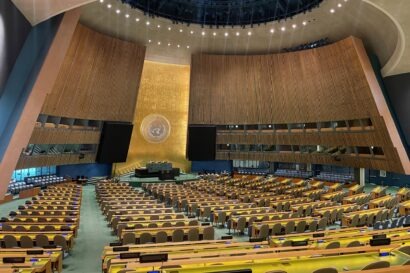The Intergovernmental Negotiation Committee on a UN Framework Convention on International Tax Cooperation will convene from 10-19 November in Nairobi. This is the third out of nine planned sessions, during which the Committee is developing three foundational texts in three Workstreams (WS): the Framework Convention itself (WS1) and two early protocols on 1) cross-border services (WS2) and 2) dispute prevention and resolution (WS3). Before the next round of negotiations, we reflect on where the main debates currently stand.
The last substantive negotiations were held in New York in August. In preparation for these sessions, Issues Notes were circulated for each of the three texts, outlining contours of the problems the Convention and Protocols are supposed to address. These served as a springboard for written inputs from member states and civil society organizations, whose submissions signaled diverse priorities (for detailed information, see a summary here).
The stated purpose of these sessions was to collect issues to be resolved rather than proposing solutions. Nevertheless, the discussion sometimes advanced in that direction already. While no decisions were ultimately taken, the debates often included interesting technical arguments and descriptions of countries’ practices and – for some parts at least – were conducted at a much more concrete level than previously in this forum.
In preparation for the Nairobi session, two documents were shared for discussion: a Framework Convention Template prepared by the Co-lead of Workstream 1, which contains draft language for some of the commitments, and a Co-Leads’ Concept Note on Ideas for Potential Solutions for the protocol on dispute resolution and prevention. The protocol on Cross-border services is not on the agenda for Nairobi, but discussions are continuing in the Workstream.
The commitments in the UN Framework Convention on Tax will define the depth of the mandate
The Co-Lead’s draft of the Framework Convention contains for now seven commitments on
- fair allocation of taxing rights
- high-net worth individuals
- mutual administrative assistance
- Illicit Financial Flows, tax avoidance and tax evasion
- harmful tax practices
- sustainable development
- prevention and resolution of tax disputes
So far, the main debate around these commitments has revolved around their degree of specificity. The November Session is supposed to find agreement on this issue. In August, most countries advocated in favor of keeping the wording in the Framework Convention broad and only making detailed commitments within the protocols, which remain optional for signatories. It was not determined yet, though, what “broad” exactly means. It is clear that commitments that are directly enforceable by tax administrations and taxpayers in their relations with each other (such as those agreed in bilateral tax treaties) are off the table for the Framework Convention. The draft commitments in the Co-lead’s template appear to mainly reaffirm several widely accepted policy goals such as exchange of information, fair dispute resolution, and cooperation against harmful tax practices, and to set an agenda for subsequent work in these different areas. But could they go further than that?
To think about this question, one could ask through what mechanisms a commitment would trickle down to a real-life impact on tax policy and the relation between taxpayers and tax authorities.
First, a commitment could already set the direction of negotiations around a given topic. For instance, if a commitment on the “fair allocation of taxing rights” include additional qualifiers that spell out what “fair” means (for instance, “where value is created, markets are located and revenues are generated”, as suggested in Article 4 of the Co-Lead’s draft template), it could be seen as giving guidance for the negotiation of Protocol I on cross-border services. However, with participation in protocols already decided as being optional for signatories of the convention, it is not clear how much of a difference in practice this will make.
Second, a commitment could also serve as guideline for domestic policy or for the (re-) negotiation of bilateral tax treaties, or as interpretative aid for the protocols and possibly other laws and treaties. When advocating for commitments that link taxation with environmental, human rights and gender issues, such mechanisms are probably what the increasing number of CSOs (among them environmental and human rights groups) that are now engaging with the work of the Convention have in mind (e.g. Greenpeace, Global Alliance for Tax Justice, Oxfam). To be able to fulfill these roles, a higher degree of specificity would likely be necessary than, for instance, in the commitments on high-net worth individuals and sustainable development as worded in the Co-Leads draft template.
But even then, it would remain uncertain how, for instance, a commitment to reduce “inequality within and between countries” (Oxfam) would be enforced. Of course, a dispute resolution mechanism could be set up to resolve such questions or citizens could attempt to hold their governments accountable in domestic courts – an emerging practice in environmental and climate change law (see examples of decisions in Switzerland and the Netherlands). However, with the protection of de jure tax sovereignty still being a widespread norm across both global North and global South, states will likely remain cautious.
Can we define the incidence of protocol 1 on Cross-Border Services?
Protocol 1, focused on cross-border services, emerged as the part with the most active participation from member states at the session in August. With OECD Pillar One effectively stalled, many delegations, including from the global North, are showing openness to a new compromise under UN auspices.
Allocation
The key division is over allocation. While OECD members and several investment hubs lean toward net basis taxation, global South delegations advocate gross basis approaches – citing not only administrative simplicity but also the importance of revenue predictability in contexts of limited capacity. Some states have suggested segmentation by margin or service type as a middle ground, but no common method has emerged yet.
The type of services to be addressed seems to be a less divisive issue. At least no opposition to the African group’s preference for covering a wide range of cross-border services (as opposed to addressing digital services alone) was voiced by countries so far – albeit this issue might still arise down the line.
Tax types covered
Then there is the question of which tax types should fall under Protocol 1. Many global South countries emphasize the need to distance the conversation from indirect taxes like VAT because of their incidence being perceived as falling on local customers. Others, particularly from Europe, note that withholding taxes, digital services taxes, or even VAT can be very similar in their design and hence generate similar economic effects. So far, there is little clarity on what a resolution of this debate would mean for the protocol, though: Would countries be required to repeal existing taxes defined to be “in scope of the protocol”, or would these become eligible to foreign tax credits in residence countries? Or would a different solution be developed for each kind of tax?
When a tax can be offset through a foreign tax credit elsewhere, the cost might be borne by the country providing the credit in the form of reduced tax revenues. When no (or insufficient) credit is provided, the incidence might fall on the customers, employees or shareholders of the firm, depending on circumstances in the market. Some evidence shows that many of the DSTs introduced in Europe in recent years might be borne by local customers, because – like VAT and other indirect taxes – these are usually not creditable. For other withholding taxes, tax credits are usually agreed in tax treaties and often provided unilaterally by the exporting countries, but sometimes only with limitations or not at all. Unfortunately, we don’t have strong evidence on the incidence and the creditability of DSTs in other regions, which are often broader in scope and often part of the income tax and hence subject to tax treaties. Therefore, less than the label of the tax, what ultimately matters for the incidence of a tax is the combination of the institutional design and its technical features, as we have discussed in a policy brief earlier this year.
Institutional design
There is some debate on institutional design, as well: Given that existing bilateral tax treaties impose constraints on the taxation of cross-border services under domestic law, African countries in particular welcomed some kind of instrument that would modify existing treaties, maybe similar to the UN Fast Track Instrument currently under discussion in the UN Group of Experts or the BEPS MLI. However, important questions remain as to how this would operate: Should signatory countries be allowed to choose the treaties they like to modify? Should any aspects be left for bilateral negotiation? Should the protocol also apply to income flows not currently covered by a treaty?
Earlier contributions by the ICTD have argued that the UN Framework Convention process can add most value – not by developing new technical standards – but by enabling political agreement on how existing tools are used. Taxation of cross-border services is not a new topic and considerable technical work has been undertaken in the UN Committee of Experts and in the G20/OECD Inclusive Framework on BEPS. Hence, rather than revisiting this debate, the main issue now is coming to an agreement on the political (and/or legal) commitment about when to use certain solutions. While a degree of optionality within the protocol might be necessary to secure broad participation, leaving too many details up for bilateral negotiation carries the risk that the protocol might not add much to the status quo, in which countries are free to adopt or modify provisions from the Model Tax Conventions in their bilateral negotiation.
Can Protocol 2 resolve old gridlocks on tax dispute resolution?
The discussions around the second protocol on dispute prevention and resolution are in an even more exploratory phase. As indicated in the note published by the Co-Leads of Working Party III, most delegations support an optional “toolbox” approach, but views diverge on scope and ambition.
For dispute resolution, two key questions appear to be whether 1) the Protocol can provide for dispute resolution in cases where there is no bilateral tax treaty between countries; and 2) whether it can move beyond the mainly diplomatic “mutual agreement procedure” which is currently standard across most tax treaties.
During the debate in August, several countries from the global South, which often have sparse treaty networks, called for the former. The reasons for this were not immediately clear though, considering that in most global South countries there are only very few cases of mutual agreement procedures under existing tax treaties.
Some countries questioned the legal viability of resolving disputes without a shared treaty base, while others floated the idea of grounding resolution in widely accepted principles such as the arm’s length principle (ALP) which could be written into the Framework Convention. Whether all states would agree with enshrining the ALP in the framework convention, while simultaneously moving away from it in protocol 1, remains to be seen.
On the second question, the idea of mandatory arbitration naturally came up. However, only a few Global North countries like France, Japan, and the UK openly defend it. Most countries from the global South oppose it, citing long-standing concerns about sovereignty and cost, and the negative experience with investor-state arbitration under bilateral investment treaties. The idea of ‘mediation’ has received cautious interest but still remains relatively undefined.
Interestingly, France reported in August that ten EU countries are developing their own Convention to establish an International Tax Dispute Resolution Commission to establish a standing group of experts who could serve as arbitrators, to be finalized this year and open to non-EU participants. Whether this process will influence the negotiations remains to be seen.
Beyond dispute resolution mechanisms, several ideas around dispute prevention were aired such as on joint audits, advance pricing agreements (APAs), and multilateral risk assessments. Protocol 2 might provide the legal baseline for such cooperation.
These discussions further revealed a more material asymmetry: the difficulty for developing countries to access transfer pricing comparables, which is one of the root causes of transfer pricing disputes. While some countries proposed creating a shared public database at the UN, developed countries raised concerns about cost, feasibility and data privacy. Regional procurement of private databases has been discussed as an alternative solution, but it remains unclear whether the protocol would have any role in coordinating this.
Conclusion
So far, the discussions did not resolve any debates, but clarified the terrain on which negotiations are beginning to unfold. However, both the substance and the form of the final output are starting to be negotiated at the same time and negotiators are starting to test how that flexibility can be used to assert their own or shape others’ priorities. While this format visibly makes the task more challenging, countries appear to be equal in their shared uncertainty of what can be agreed, which could be considered as an aspect of inclusiveness. Whether it will ultimately be successful in delivering effective solutions is of course another question. On the side of those driving the process – particularly the African Group – there remains a dilemma between advocating in favour of radical changes and those that are agreeable to a large number of countries. Nevertheless, for now the negotiations have moved past the point in which the desirability of the process itself was the main point of debate: certainly a success for the initiators!



